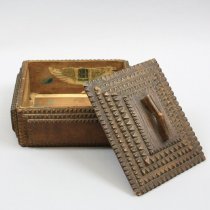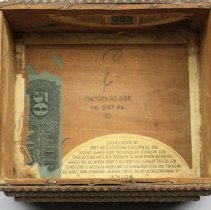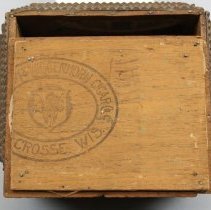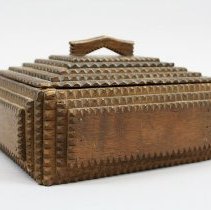Object Record
Images




Metadata
Object Name |
Box, Cigar |
Catalog Number |
2015.024.001 |
Description |
Wooden Pamperin and Wiggenhorn cigar box refashioned into a tramp art trinket. The note that came with the box stated "Tramp Art Trinket Box Made from 1900: La Crosse Wisc, cigar boxes" and on the bottom of the box "1901" is written. Most of the paper and labels from the cigar box have been torn away, intricately carved wood pannels have been added onto the sides and top of the box in a pyramidal fashion as well as a handle on the top. On the inside of the box a batting and peach colored silk covered piece of cardboard was placed in the bottom to act as a jewlery box. This piece was put together with both machine and hand stitching. |
Date |
c. 1901 |
Material |
Wood |
Dimensions |
H-4.25 W-6 L-7.25 inches |
Length (in) |
7.250 |
Height (in) |
4.250 |
Width (in) |
6.000 |
Place of Origin |
La Crosse, WI |
Subjects |
Businesses "Things that Matter" |
Search Terms |
Pamperin & Wiggenhorn Cigar Company "Things that Matter" |
Notes |
Featured in Things that Matter: Wooden boxes have often been saved over the years and then given new life storing things like trinkets, receipts, recipes, and sewing supplies. Sometimes these boxes were altered by adding initials or stickers, and other times the boxes were reconfigured entirely. This box is a piece of tramp art made from parts of a La Crosse cigar box from the Pamperin and Wiggenhorn Cigar Company. The manufacture of cigars was a big industry in La Crosse after the turn of the twentieth century and the city has been the home to over 20 cigar manufacturing companies. Tramp art is a style of folk art typically made from wooden cigar boxes. Cigar boxes were a one-time use item because Federal laws prohibited their re-use. Boxes were readily available due to the popularity of cigar smoking and were sold for mere pennies. This art form is made by cutting a series of small notches in the wood with a knife and layering the wood to create a variety of three-dimensional patterns such as pyramids, ovals, stars, hearts, and others. Anything from picture frames to jewelry boxes to armoires was created in this style. Sometimes the artwork from the cigar box was incorporated into the final design; however, most of the paper labels that were once inside this box have been torn away, but the Pamperin and Wiggenhorn logo is still present beneath the lid. The layers of the box that create the pyramid shape are held in place by small nails. As legend has it, tramp art was named after the artists. People thought that vagabonds or tramps made these pieces as they traipsed around the world. However, these pieces took a great deal of dedication and attention to detail to create; they are not something that could have been done on the road. Tramp art was primarily produced by the working class and was influenced by European woodworking styles. In the U.S., tramp art was popular between the 1870s and the 1940s. This box falls right in the middle of that period with a date of 1901, as is written on the bottom of the box. There were a lot of tramp art pieces created in Wisconsin. While the artist of this piece is unknown, it represents a nationally recognized art form using a local cigar company’s discarded boxes. This article was originally published in the La Crosse Tribune. Title: La Crosse Cigar Box Tramp Art Author: Amy Vach Publish Date: November 2, 2019 |